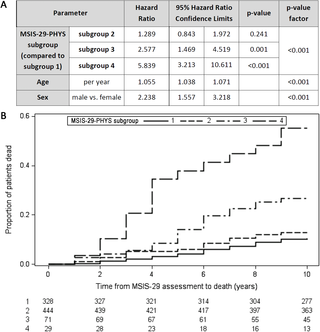PLOS Medicine ( IF 10.5 ) Pub Date : 2017-07-10 , DOI: 10.1371/journal.pmed.1002346 Joel Raffel 1, 2 , Alison Wallace 1 , Djordje Gveric 1 , Richard Reynolds 1 , Tim Friede 3 , Richard Nicholas 1, 2

|
Background
There is increasing emphasis on using patient-reported outcomes (PROs) to complement traditional clinical outcomes in medical research, including in multiple sclerosis (MS). Research, particularly in oncology and heart failure, has shown that PROs can be prognostic of hard clinical endpoints such as survival time (time from study entry until death). However, unlike in oncology or cardiology, it is unknown whether PROs are associated with survival time in neurological diseases. The Multiple Sclerosis Impact Scale–29 (MSIS-29) is a PRO sensitive to short-term change in MS, with questions covering both physical and psychological quality of life. This study aimed to investigate whether MSIS-29 scores can be prognostic for survival time in MS, using a large observational cohort of people with MS.
Methods and findings
From 15 July 2004 onwards, MSIS-29 questionnaires were completed by people with MS registered with the MS Society Tissue Bank (n = 2,126, repeated 1 year later with n = 872 of the original respondents). By 2014, 264 participants (12.4%) had died. Higher baseline MSIS-29 physical (MSIS-29-PHYS) score was associated with reduced survival time (subgroup with highest scores versus subgroup with lowest scores: hazard ratio [HR] 5.7, 95% CI 3.1–10.5, p < 0.001). Higher baseline MSIS-29 psychological score was also associated with reduced survival time (subgroup with highest scores versus subgroup with lowest scores: HR 2.8, 95% CI 1.8–4.4, p < 0.001). In those with high baseline MSIS-29 scores, mortality risk was even greater if the MSIS-29 score worsened over 1 year (HR 2.3, 95% CI 1.2–4.4, p = 0.02). MSIS-29-PHYS scores were associated with survival time independent of age, sex, and patient-reported Expanded Disability Status Scale score in a Cox regression analysis (per 1-SD increase in MSIS-29-PHYS score: HR 1.8, 95% CI 1.1–2.9, p = 0.03). A limitation of the study is that this cohort had high baseline age and disability levels; the prognostic value of MSIS-29 for survival time at earlier disease stages requires further investigation.
Conclusions
This study reports that PROs can be prognostic for hard clinical outcomes in neurological disease, and supports PROs as a meaningful clinical outcome for use in research and clinical settings.
中文翻译:

多发性硬化症患者报告的结果和生存率:使用多发性硬化症影响量表进行的 10 年回顾性队列研究–29
背景
人们越来越重视使用患者报告的结果(PRO)来补充医学研究中的传统临床结果,包括多发性硬化症(MS)。研究,特别是在肿瘤学和心力衰竭方面的研究表明,PRO 可以预测硬临床终点,例如生存时间(从研究进入到死亡的时间)。然而,与肿瘤学或心脏病学不同,PRO 是否与神经系统疾病的生存时间相关尚不清楚。多发性硬化症影响量表 – 29 (MSIS-29) 是对 MS 短期变化敏感的 PRO,其问题涵盖身体和心理生活质量。本研究旨在通过大量 MS 患者观察队列研究 MSIS-29 评分是否可以预测 MS 的生存时间。
方法和结果
从 2004 年 7 月 15 日起,MSIS-29 问卷由在 MS Society Tissue Bank 注册的 MS 患者完成( n = 2,126,一年后重复, n = 872 名原始受访者)。到 2014 年,已有 264 名参与者(12.4%)死亡。基线 MSIS-29 物理 (MSIS-29-PHYS) 评分较高与生存时间缩短相关(得分最高的亚组与得分最低的亚组:风险比 [HR] 5.7,95% CI 3.1–10.5, p < 0.001) 。较高的基线 MSIS-29 心理评分也与生存时间缩短相关(得分最高的亚组与得分最低的亚组:HR 2.8,95% CI 1.8–4.4, p < 0.001)。对于基线 MSIS-29 评分较高的患者,如果 MSIS-29 评分在 1 年内恶化,死亡风险甚至更大(HR 2.3,95% CI 1.2–4.4, p = 0.02)。 MSIS-29-PHYS 评分与生存时间相关,与 Cox 回归分析中的年龄、性别和患者报告的扩展残疾状态量表评分无关(MSIS-29-PHYS 评分每增加 1-SD:HR 1.8,95% CI 1.1–2.9, p = 0.03)。该研究的一个局限性是该队列的基线年龄和残疾水平较高; MSIS-29 对早期疾病阶段生存时间的预后价值需要进一步研究。
结论
这项研究报告说,PRO 可以对神经系统疾病的硬临床结果进行预后,并支持 PRO 作为有意义的临床结果用于研究和临床环境。











































 京公网安备 11010802027423号
京公网安备 11010802027423号